|
Having completed the last panel (actually, I have a further 'Uccello drawing' to create and paste into several panels), I am now turning to the cover and publication design. The course is thoughtfully organised in terms of having all this work be part of semester 2's Comics Production module. Unfortunately for me, after designing that material, based on my major project being a continuation of semester 1's comic about Vermeer, I refocussed my project to a series of comics about different artists, ultimately deciding on Uccello for my semester 3 Major Project changed tack. I'm getting the proverbial 'deja vu all over again' since I spent much of the time in the Production module finishing of my comic from semester 1. Had I not had to do that I would have time, I would have had time over semester 2 to do the revised design work, that I'm now having to do in semester 3! I hope I get some recognition of having to do a whole extra design/production job as well as my major project. That said, I'm not totally starting from scratch, as I did some basic design/concept work earlier in semester 3, as shown below. Below is my sketch for the back cover - essentially takes some of the panels from the interior, and sets up the story: the commission, and the fact that it is a challenge, and a step up from his previous work.  I imported the images into Manga Studio, and took them slightly further, as shown below. I don't have a lot of time at this stage, as I still have some texture/toning/lettering work to do on the interior pages, ands some final work on my business plan. To get the cover done, and leave enough time for the rest of the work, I've put the cover together by cutting and pasting elements from the interior pages: Uccello sitting drawing from page 1; Rocco brandishing his sword at Uccello from page 17; and Uccello at work on ht big drawing from page 21; background from pages 20-21; and the armour and props on the floor from page 12. For the Uccello/Rocco one that 'shot' was cropped in the interior, but having saved the 3D models I was able to add the legs accurately, and fairly easily - the 3D models won't resize with the rest of the drawing using the Transform function, but it wasn't that much more difficult to do this using the 3D model manipulation tools. I think the result is pretty convincing - I did anyone (without closely comparing it to the interior) would guess I'd done this.
I've also started on some of the design elements. The top have design is based on classic Marvel comics with the inset bow identifying the character, the horizontal band for the company nam, and the mixture of typeset and hand-lettered text. I think my combination of type and hand-lettered style fonts works quite well, though the spacing/composition could probably be finessed. I like the left alignment on the PAOLO UCCELLO 'logo', with the two 'LO's left aligned. I placed the text 'This perspective..' to fill that space - it's to be a word balloon, as shown on my sketch. I might be able to fit it into the inset box. My original plan had been to fill that space with an image/silhouette of a rider, from one of Uccello's paintings - the rider in the painting to be seen (in my rendition) on the back cover. I've just been doing this in Manga Studio as I find it helps me to be working on the picture and design elements together. I may take it into InDesign to finalise, MS isn't very clever with, for example, getting the different bits of text aligned to centre. I'm not sure if it will let me import (after outputting from MS as aPSD) the text in editable form - I'll make some enquiries.
0 Comments
I use Dropbox (cloud storage) to save my files - the main advantage of this is that I can access my work either in my studio, or at home. In these final days before hand-in, to maximise my productivity I have doing a day's work in my studio, focussing on the actual drawing, then going home and doing a more hours working on the work-a-day elements like fixing the lettering, applying texture and tone layers consistently to pages, and generally fixing any glitches or niggles. The problem I have with Dropbox is that, as a back-up save (in my use of it) it doesn't save to Dropbox in the same time it takes to save to the computer, so it's not unusual to find that I can't access from home the version I just completed before I left the studio. I've learnt how to work around that, in fact it's partly why I do colouring etc at home - that's usually on pages I've done some time before, and therefore are accessible inter most recent versions on Dropbox. Today, though in the studio, I can't access any of the work i did at home last night. Additionally, while Clip Studio's page management system is clever enough to know when the file has been changed elsewhere, and ask me if I want to update to that, I'm not sure how it would work if I had two sets of changes made in different places, so I'm avoiding finding out! For the panel I'm working on (post immediately below), I've just copied what I want into a separate single page document, and from there I'll post onto the page-managed version later.
I had completed, a week or so ago, the two-page spread that makes up pages 20 and 21 (below). However after doing that i decided that the last panel made more sense over on the 22nd, and final page, which then is able to feature the protagonist having a concluding engagement with each group of supporting characters. That left me a panel to fill on page 21, and I thought a (possibly) silent moment of Salimbini (the patron) assessing the progress (he's expecting to see painting on the walls, but there's only a drawing. Before I arrived at the final version of panel 3, I had tried a few poses for Uccello waking/getting up. so one of them might be right for the new panel. As it happens I also drew a panel yesterday (for page 15 - see post immediately below), with a similar pose to what is required here - Sailbini with his hand to his chin. This took a significant length of time to wrangle the 3D model into such a specific pose - getting the hand moved into the pose is one thing, but connecting that with the chin is quite another, I kept ending up with the hand behind or in the middle of the head. I think it will be good to adapt that pose for this panel, not just because I have little time left, but also because i think is good to reprise visual details - the things which are similar hopefully emphasise the differences. In the case of this scene, I hope it will (consciously or sub-consciously0 remind readers of the earlier, similar scene, and so the escalation of the situation. That would be helpful here, at this climactic, 'how will end' moment. This panel probably should be zoomed in, so that it shows a closer up view of the finished drawing. I copied the background from the existing version into a fresh Manga Studio page, and increased the size of this within the panel border to maximise the amount of the drawing shown, but also to include just enough of the surrounding wall and woodwork just to make it clear that this is a zoom into the same scene, and also to provide an aesthetic composition within the panel border. After cropping my source scene, I realised I needed a copy showing the wider room and tile pattern to help position the figures correctly in perspective space, so I pasted one in and reduced the opacity, so I could refer to it without it distracting from the drawing in progress. Next I found and copied in the chosen 3D models (I now always keep the ones I have used in hidden layers within each page) - Salimbini from page 15, and Uccello from page 20, panel 1 (above - lower left panel). I then amended these - for Salimbini, just rotating it slightly, to match the angle we'll see in the panel on the next page, and for Uccello, trying various adjustments to the sleeping pose to suggest various moments within the process. In working out the poses, I did revisit and tweak the cropping of the zoomed in room view to crop the figures aesthetically. This was easy for the standing Salimbini, but harder for the recumbent Uccello, some options showed, for example, a bit of his head, which looked slightly silly and confusing. In the end just showing Uccello's arm stretching up and out from his position on the floor, seemed a visually appealing, and, i thought, witty solution. In theory I could have just drawn the arm without the bother of using 3D models, but I wanted to have the placement accurate in terms of continuity, and realistic in terms of bodily movement. I was also careful to check, e.g. that the figure was correctly placed on the floor, using the floor tiles, (outside the frame in this shot), as a guide. Finally, I took some care to place Uccello's hand to get the best placement, in terms of avoiding tangents with the horizontals lines of the paper and woodwork. Below is the inked version. I'll add some balloons for Uccello with 'ZZZ's and then a waking up grunt, just to make it clear what is happening.  tI also pasted into my new document the Colour flats layer, to let me save a bit of time and have it fully ready paste in. I just selected the areas with the old figures and dragged them out the panel, which means I can conveniently eyedropper the relevant colours, and so flat this (admittedly simple) panel in a few short minutes. I've now added text and balloons. The next step is to paste in my already created drawing of Uccello's painting, which I used in the imagined battle scene (Page 19), when Uccello is wearing the helmet, and Rocco is 'helping' him imagine the battle. This drawing is a later (within the story) and so more finished version than that in the main panel of pages 20 and 21, (as at top of this post). I'll likely need to finesse the positioning of the balloons, in relation to the pasted in drawing. Also, in this case I have kept Uccello's sleeping noise balloons low in the panel, to reflect his physical position, and Salimbini's high in the panel. I did indeed have to rearrange the lettering, considerably in relation to the pasted in drawing (below). I still have to add the tail between the 'zzz' and 'grunt!' balloons. The other two balloons are Salimbini's thoughts, perhaps unstated. I previously tried using a set of little bubbles, in lieu of a tail, to indicate thinks bubbles, but it just didn't look good. Where I've used it, it's usually fairly obvious from the image whose thoughts it is. I'll leave this until later and see if I need to put a tail between them this two ballots/bubbles.
In retrospect, I would also have ben better to have pasted the drawing in first so I could finesse the positioning of the figures in relation to it. It's fine, as it is, but i could have got it subtly but significantly better. Still, it's pretty good, I doubt anyone else will see anything wrong with it in that respect! The 'drawing' looks a bit pixellated in this 150dpi version - it looks much better in the original doc, and I trust it will in print. Despite my comments above, about wanting to get Uccello's reaching up arm positioned correctly, I am tempted to move it over to the left 1cm into that blank space. Although I have drawn the last page, I have some panels to go back and add, including one of page 15, as shown below. It's slightly technically complicated, as I've got to get from Uccello sitting in panel 4, while he stands holding up a drawing,to panel 6, where Uccello holds up a drawing as the patron, Salimbini, sits on his stool. Also, Rocco (the patron's 'major domo', in brown jacket) is there, so what is he doing? It's so long ago I drew this, I have been unsure what my initial plan was. I had been assuming the figure to the right of my sketch for panel 5 was the seated Uccello, but I I realise now that (from my roughly sketched hat!), it is Rocco holding up the drawing, with Salimbini on the right, panel 6 then is almost a mirror image, with Salimbini turning to look at Uccello, who is holding up a drawing to juxtapose with the first one: two drawings of horsemen together now suggesting they joust each other. I think it will be confusing to have Salimbini drawn as if he is sitting, as we don't seem him in the act of sitting, or him on the stool - it's just the head height - which might just look like bad drawing!. Panel 6 was an early one, and may be worth redrawing anyway. I'm thinking now I need need to overall the drawings - it's probably better to let the reader have to imagine it - just as the patron is. We see the two riders coming together in joust, anyway, in an imaginary/symbolic scene on the very next page. So I'm concluding that the arrangement works, if I just make Salimbini standing. I had thought about turning it into a single panel, perhaps with a double image of Salimbini facing in each direction, but I think two panels will be better, as I captures that a moment has passed between Rocco holding up one drawing, and Uccello holding up the other. I also have to add the drawing of the hat on the wall in a number of panels. I also have to fix the lettering, from the widely spaced version seen on most of this page to the better spacing, and smaller size seen in panel 4, above. UPDATE - I've just realised why I had the patron sitting down - him being lower down means he's not in the way of the drawings for the reader. Still trying to solve this... I've redrawn the figures for panels 5 and 6, ti work as a pair. I've still finesse the composition the horsemen drawings and the paper edges. I've now added the drawn images and the pieces of paper they are on - it was a bit of work getting these three elements and the word balloons, all composed together nicely. I placed the drawn images so that those parts Uccello didn't draw (i.e. they were hidden behind other riders) are hidden in the rolled parts of the paper.
I'm undecided about whether to add tones - they might act against the flat quality I wanted to suit my subject's style. Nonetheless I have tried a few attempts. The version below is before application of a tone layer. In the version below I used the magic wand tool to select areas and then went over then with a large textured airbrush, and a single colour a lilac/grey. It ended up just looking like airbrush. Also the areas areas that most needed tonal distinction - between the faces and background, were so close in colour and tone as to be not easily selectable by the magic wand. I tried going back over with an erase to define the edge of faces - don't think it worked particularly well. I tried a similar approach, but with a charcoal brush, and it looked much the same. My third attempt used a brush called 'Painterly_02' at 310 size. It worked okay on the faces, and on the green backgrounds, where it creates a quite appealing richness - does it really help it as a comic though. The issue may be that there is too much contrast over the hot coloured areas, and they might work with the same brush in a different colour.
For what's page 4, of the long version, most of the images were taken form my aborted 4 page comic, as seen in the image immediately below. I had done a fair bit of work on the original in creating these elaborate balloons, and pacing them, in a fairly dense and text heavy comic. I felt this page needed an outdoor shot to help the transition between Uccello's home/studio, and the cathedral or 'Duomo', so rearranged the page, including this, in the version below. I also redrew the figures, using the 3D models, and image of the horseman in the tall panel. I had been pleased with some of the original images (though somehow, in panel 2, above, i managed to get a hand the wrong way round!), I had created them in Manga Studio 4, with mu old graphics tablet, and heavy correction (they call it ‘stabilisation’ on MS version 5). i had developed a certain mastery that made the correction look good. I particularly liked the panel on the bottom left (in the version above). Anyway, long story short, they look incongruous with most of the later pages, so I decided to go back and change them. In the last panel, I spend some time getting the 3D models dragged into roughly the same composition, and capturing Uccello’s pose as he ‘bows and scrapes’ as they call, before a person of high status. I think the revised version lacks the compositional energy of the original, and looks stilted in comparison, but ultimately, it’s not going to distract readers by looking incongruous. I have now, at different times redrawn all of the figures - all that remains from my original is the painting and architectural feature.
I've just noticed that panel 5 is missing the patterned floor - I think I just made it invisible, while working on other elements, and that it's still there in the page files! I've gone and fixed this. i've also noticed a slight ghost image of the figures, which was an earlier attempt at them - I've now deleted that. I also had to what I call 'underdraw' the figures with white so the floor pattern isn't showing through them. This then obliterated the perspective lines, which I want to visible. This would be overdone if i used it repeatedly, so I've only used it in panels where we are seeing through Uccello's eyes, as here. I tried moving the perspective lines to on top of the figures, but then they were too strong over the architectural features, so i duplicated the later, and put one above and one below, reducing the opacity of each from 30% to 20%. There's also a stray line at the bottom of Rocco (left)'s jacket. I've also gone back and fixed that. it was surprising hard to get that one line for his leg right - happily I always save the 3D model layers so I just had to make that visible. These are examples of the numerous corrections I am continually making, to get the best pages. I added the walking figure of Uccello to panel 1. My initial idea was that we were seeing the outside, as Uccello was inside, but removing one of the word balloons from version two created the space to do that. It seems a sensible addition. I have continued to experiment with textures. the page in the post below uses the 'plaster' and distressed' textures I have used in other pages, but perhaps more successfully here. I also pasted the distressed effect over the tiled floor, only, here and some other pages, to give a marble like effect.
Otherwise, I've been concentrating on getting the pages draw, and redrawing some early pages that now look pretty weak. The character Rocco wears a sword, that he brandishes at Uccello on page 17 (below). It occurred to me after completing and colouring the page, that in the scene where he is brandishing the sword, I omitted to draw in the scabbard. I went back to add it by pasting from another panel (see line image in main picture, below). It was hard to compose in relation to the image, but I got it satisfactory in that panel. The scabbard would actually be mostly hidden behind his leg. In the other two panels, there is only going to be a tiny bit of it visible, and coloured the same as his belt, so I think it will just be confusing.
So the question is - complete accuracy, or what makes more visual sense? I have previously posted on this sequence at earlier stages. This is near the end of the story, and Rocco (the patron's major demo) has got Uccello to put on armour he has for reference (miraculously it is a perfect fit!), and a bit to 'put him into the battle' and enable him to bring his studies together into the battle scene(s). My plan was that these pages would have essentially the same shot of Uccello on a stool, but overlaid with his imagined images of the battle. I decided to extend this sequence to two pages, one advantage of this is that I was able to use row-wide panels, reflecting the aspect ratio of the paintings the story is about. I was able to draw the room background and paste it into the other panels, and the same with Uccello on the stool. I had the pages drawn, and still had to add the details of Uccello's imagining of the battle. The next task was to overlay on panel 3 the first stage of Uccello's imagining of (not yet the battle itself) the scene of the battle. I wanted this to reflect an earlier panel (below, from Page 11) where Uccello had tried to map out in perspective the battle scene. I pasted in Uccello's perspective space, from page 11 (above), overlaying this on the already colour flatted page. I duplicated the blue perspective layer in white and placed it under the blue, to make these lines stand out. I made use of a lot of the special tools like pencil, pastel and airbrushes, and brushes for specific effects such as grass and trees. It was helpful to have a chance to explore these various tools, and in many ways the effect is successful, but perhaps too incongruous with the overall style. I decided to leave this for the time being, and work on the, more complex, second page of this scene. The second page would have overlaid scenes of the battle - drawn from Uccello's paintings, as sketched in below. It’s worth noting here that I changed, from my original roughs, the direction Uccello was facing. The position of the characters and stool in the room, in terms of a cinematic continuity, suggested (keeping a fixed camera) Uccello would be facing to the left. This is of course goes against the conventional reading direction (in the West) from left to right, but it would have fitted with the power relations in the scene, that Uccello was feeling somewhat disempowered and disoriented. However, swapping it to have him facing right was ultimately a far better approach, because it let the elements of the Uccello painting face in the same direction, and indeed, in that the battle moves from left to right.  I had already inked/pasted elements on to the page, including the flats. It is more traditional to leave flatting until the drawing/inking stage is complete, but I knew I wanted the background flatted in, to overlay the imagined battle scenes over. The exception to this was the middle panel, which represents his total immersion the imagined battle, and so would have no visible trace of his actual surroundings in the patron's room. In the end I was able to take the battle elements directly from Uccello's painting (The Battle of san Romano - 1st of a series of three paintings, this one in London). This was good because my underlying reason for the comic is to reimagine and illuminate the process of making the paintings, and this then showed elements of the battle imagined before being realised in the final design. I pasted the painting into Manga Studio as a reference layer to overdraw. In the first panel I chose and carefully placed elements of the images that reflected my text: his 'fellows behind him', and the opposing forces 'approaching'. In the second panel, I used all the foreground figures from the painting, again, carefully arranging these in the panel for the best composition. This was somewhat constrained by wanting to be true to Uccello's composition, and the figures needing to be broadly to scale in relation to the repeated image of Uccello. I did consider reducing the size of the armoured figure of Uccello - this would have given a sense of the scale of the battle in relation to him, but in the end, I decided that the visual elegance of keeping the Uccello figure the same outweighed the slight mis-scale of the figures. Removing the border of this panel helped in a number of ways: it gave me more space for the figures, and to work the lettering around them, it also made the composition look better, and most importantly it reflected a shift for Uccello, from being in a room imagining a battle, to actually being there, in open space, at the battle. The cropping of the furthest left figure, partly came out of getting the best arrangement of the other figures in relation to the fixed position of Uccello, but it fits with what Rocco (out of camera) is telling Uccello, that he is safe with the Florentine forces behind him: we see only a single opposing horseman, whereas Uccello's 'fellows behind [him]' extends off the page, as if to infinity... 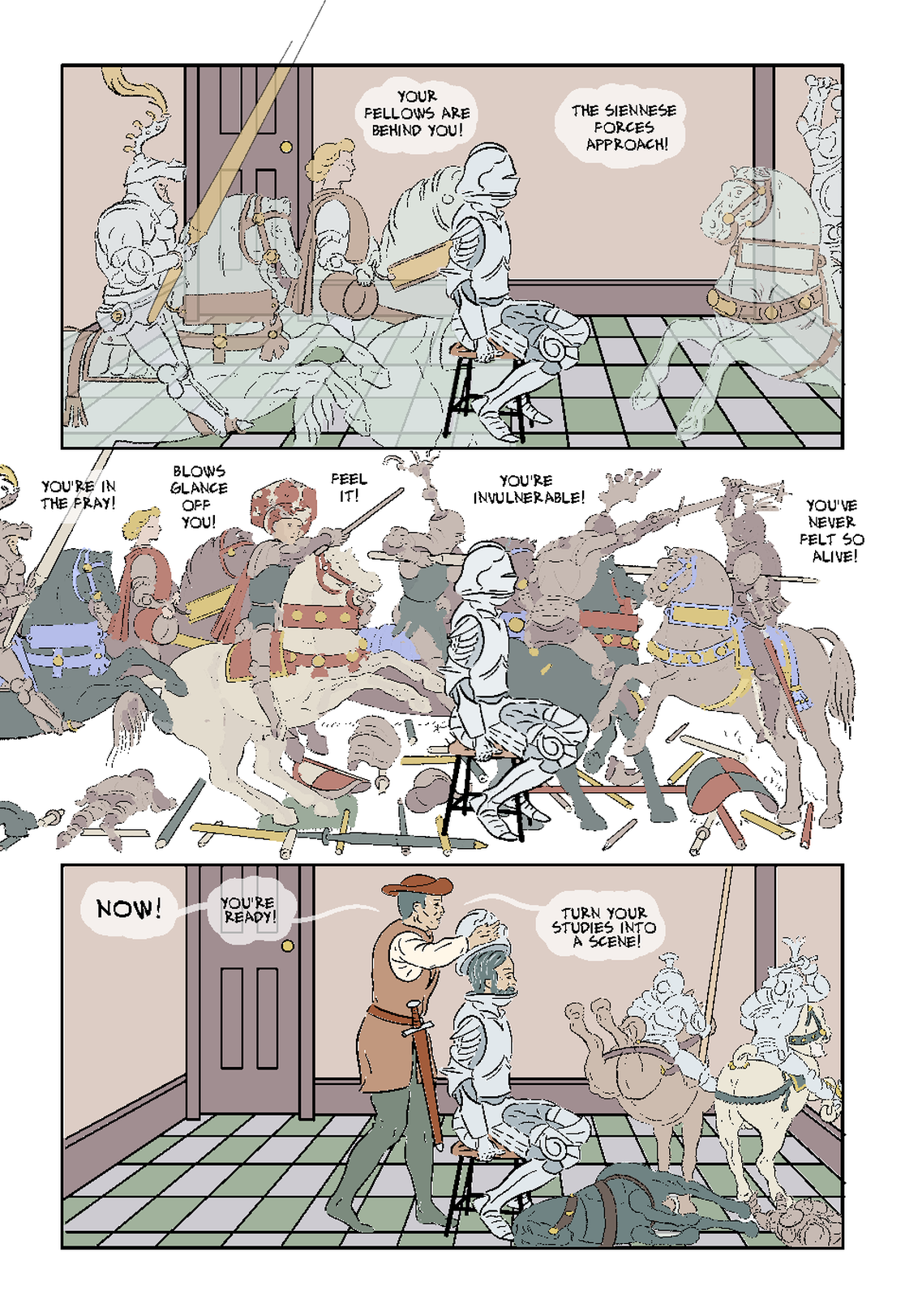 For the third panel (above), I wanted to suggest Uccello's vision lingering, and slowly 'evaporating', as Rocco removes the helmet from him. After some study of the Uccello paintings, I decided to base the imagined images on Uccello's second painting (below left) in the series, specifically the bottom right of it (below, right), which shows a fallen horse its armoured rider, and two riders racing away from the scene. The placing suited the sequentiality within my panel , where (working from top right) we have seen the empty room, then Rocco bringing Uccello back to it through removing the helmet, and finally, we see his vision in the process of leaving him. It's worth saying something here about the rendering. I wanted the imagined figures and horses to seem a bit less real and tangible than the room and Uccello, and I used a number of techniques to achieve this, including drawing them in 'pencil' and colouring them (at times) on translucent layers letting the background show through. That's easier to say than it was to do though! I have a number of 'pencil' brushes for Manga Studio, but it still was not easy to find one that (within an inked and coloured page) looked obviously like pencil, and not just grey lines. I chose the most suitable, and worked on a Monochrome rather than Greyscale layer. While this didn't clearly scream ‘pencil', it did give a less dark and tangible line than inking, (and is not as pixelated as the fairly low res version posted above). This technique proved slow and laborious to colour flat, as the colour would leak through any weak points in the line, so I had to do a considerable amount of drawing in lines with a marker before filling, and still had to erase numerous overflows. Possibly working with an enlarged view of the picture didn't help, as, in hindsight, I was possibly fixing things most readers either wouldn't have spotted or registered as wrong.
It’s not usual to add colour flats while the pages are unfinished (perhaps reflecting the ‘Ford Factory’ division of labour in mainstream comics), but it worked here to add the flats, as I wanted the imagined images to look ghostly, and show the background behind them. To this end I overlaid a further colour flat layer, with reduced opacity, and coloured the images on that. This also gave the advantage that I could modulate the level of opacity for the best balance on the finished colour layer. The imagined images don’t look quite translucent enough in the version above, but I have since gone back and fixed that. Panel 2 though, required a slightly different approach, as here i was trying to convey that he has now forgotten his actual surroundings in the patron’s room, and is immersed in the battle scene. However I still wanted the battling figures to look less real and solid than the figure of Uccello. First of all I created a new flat layer and coloured all the battling figures in a flat grey/brown - this gave quite a pleasing silhouette effect. Over this I added a reduced opacity coloured layer to colour the individual details - this achieved the intended effect of both greying the colours, and retaining the silhouette effect slightly. To add some subtle modelling I went back and applied a darker grey/brown to parts of the ‘under-draw’ layer. This page has been perhaps the most work of any, but I think has solved a problem I was leaving off, as is suitably impactful for this climactic scene. I will also be able to use my drawn battling figures for my versions of Uccello’s developing designs for the painting, on the next pages. I've previously posted about balloons, but here I want to extend that to captions and thought bubbles. I'll begin by recapping my thinking on the balloons. My initial pages for the story, in an attempt to create a period effect, used balloons that looked like scrolls and banners. Initially I tried to use a different style of 'balloon' for each character. It looks quite nice on some pages, but at other times, like this draft of page 9, it got a bit busy, due to the combination of different characters speaking, and thought bubbles.  Changing the text to the Alex Toth (tribute) hand-lettering font makes it look a bit better (note, I improved the spacing after I did this page). I think my decision to change the balloon style to the borderless style shown below, was a good one. I think that the borderless balloons manage to be readable, without encroaching on the drawings. There is no point trying ti update the balloons on the above example, as it only reads against a coloured backgrounds shown below.  Narrative captionI have occasional captions, which require to be clearly distinguished from the dialogue balloons. The first one i attempted was on page 14, as shown above. I drew a scroll shape just in white, with no border, which seems to work pretty well. There are also a couple of instances of Uccello's thoughts that need to be either captions, or thought bubbles. A few lone rectangular boxes might look incongruous, and scrolls might cause confusion with the narration captions, e.g. '...and yet later...' as seen above. Perhaps the best solution is actually obvious and simple - have them like the speech balloons, which, (lets face it), are more like bubbles anyway, but instead of tails, use the traditional small bubbles to indicate whose thoughts it is. That seems sensible, but I won't know for sure until I try in on a real example. Thought BubbleIn the page below I had a thinks balloon/caption required in the bottom right panel. I tried a few options, of which this was the least worst. I think it's hard in this panel, as the thought bubble is a response to the word balloon, so needs to be read after it. not sure I've solved this, but will keep trying.
|
AuthorGraham Johnstone ~ Master of Design - Comics and Graphic Novels student 2016-17 Archives
August 2017
Categories |

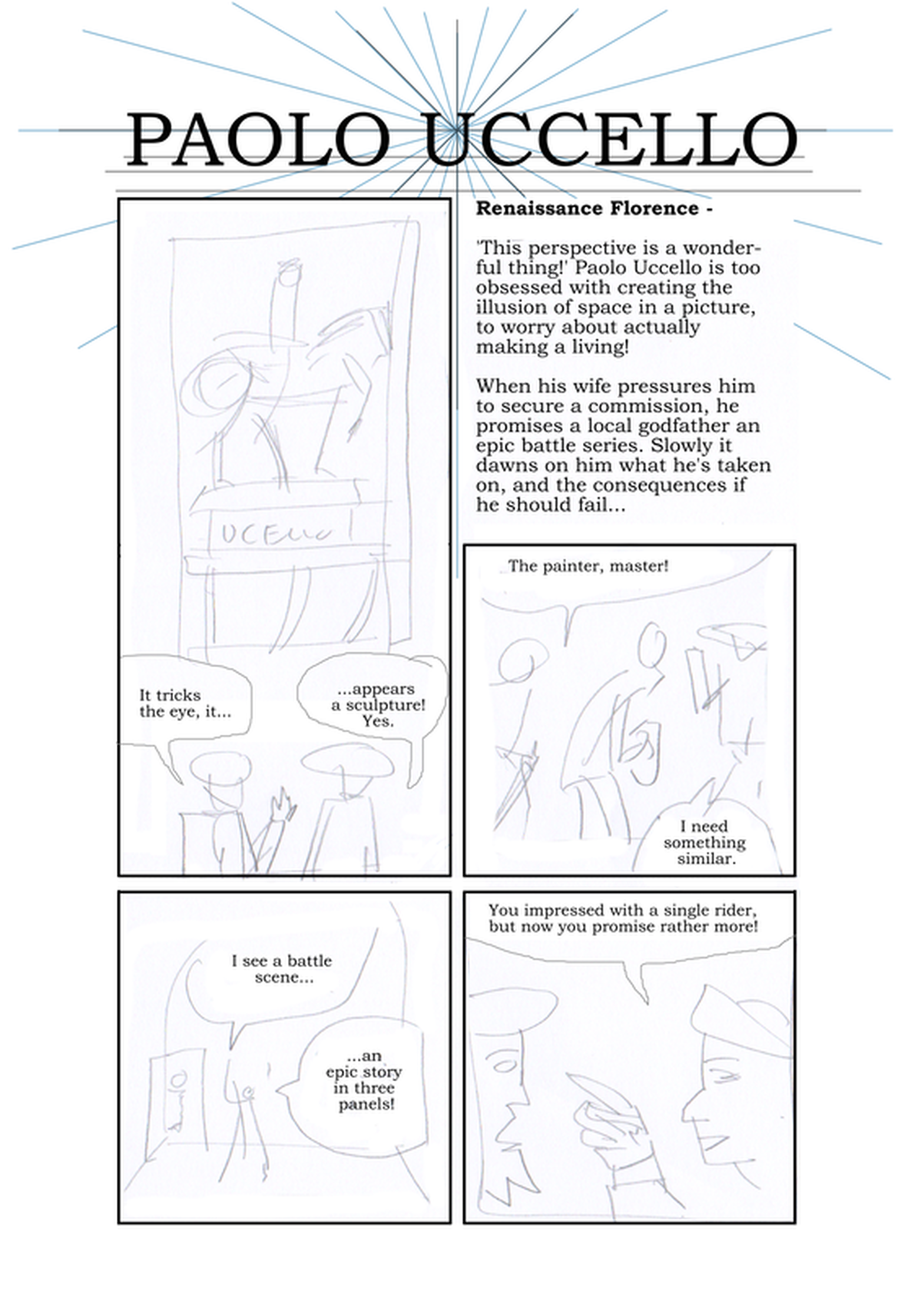
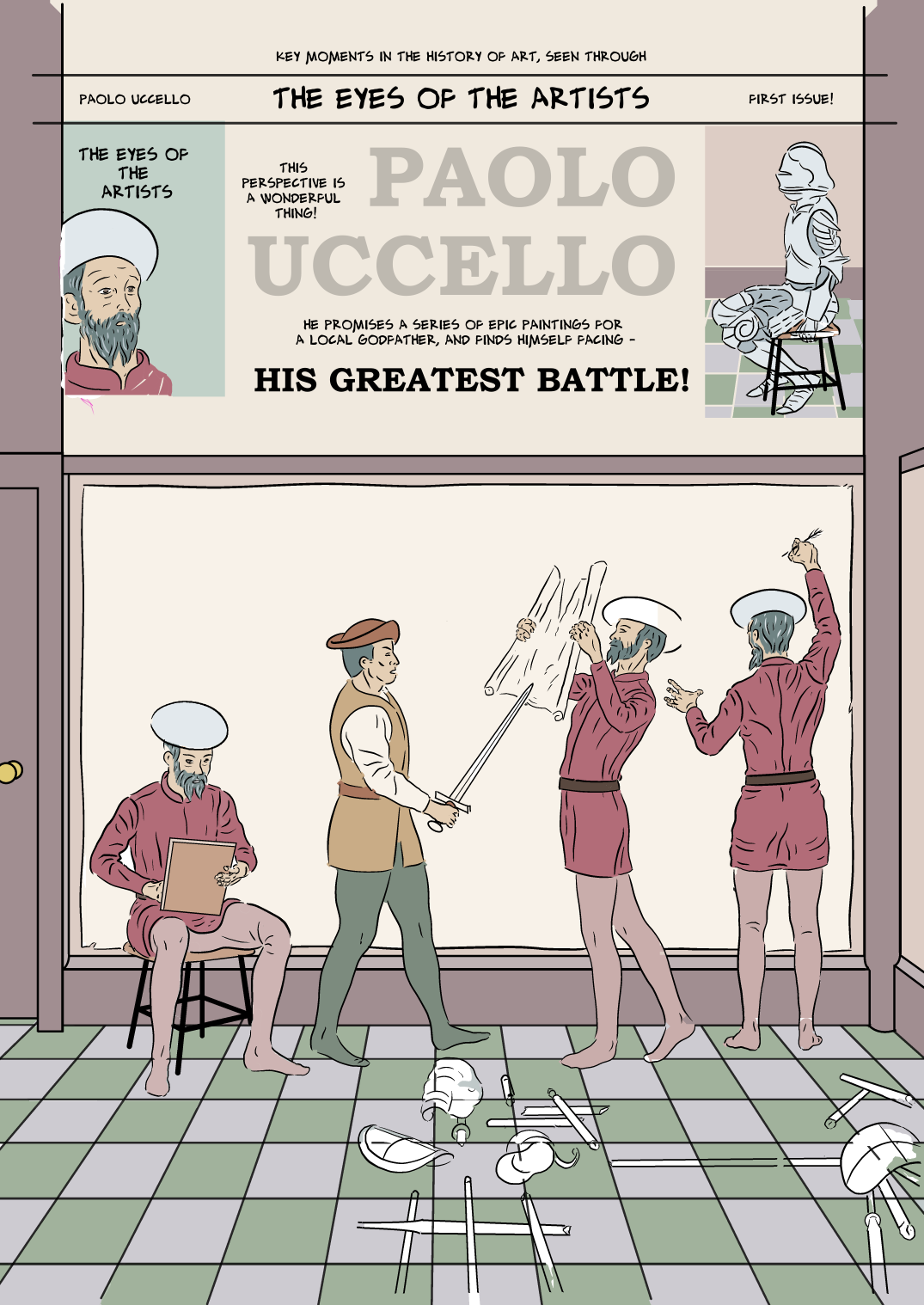












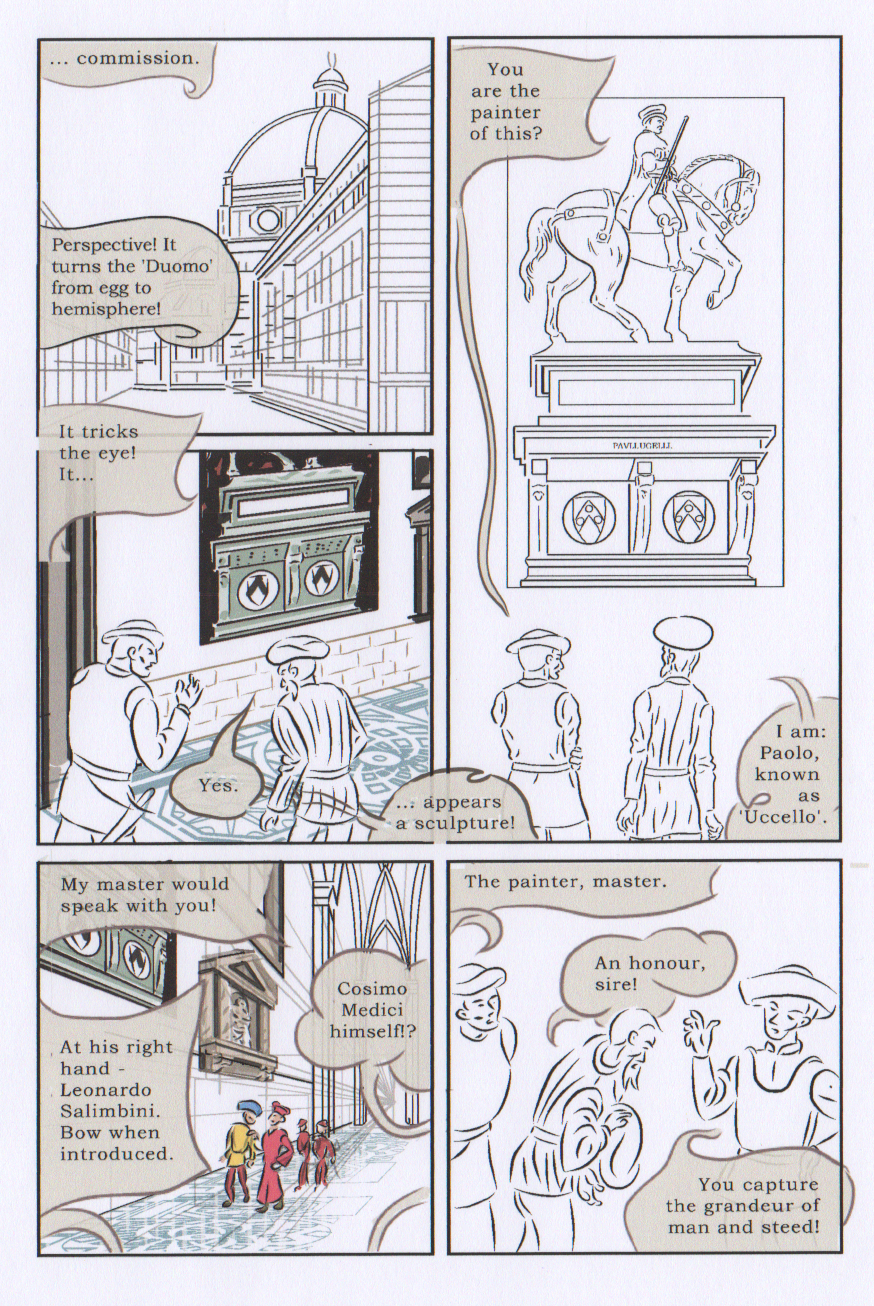
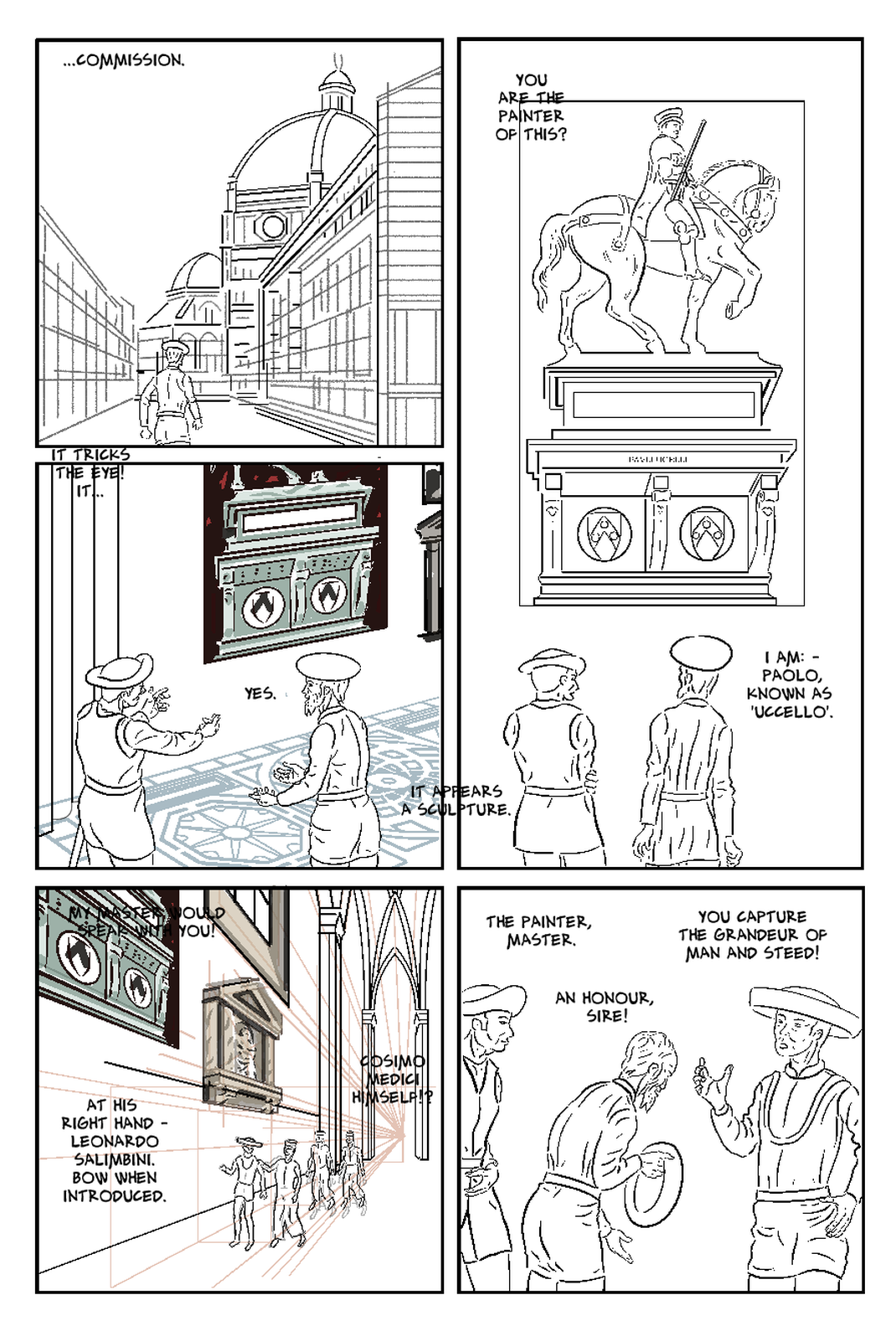

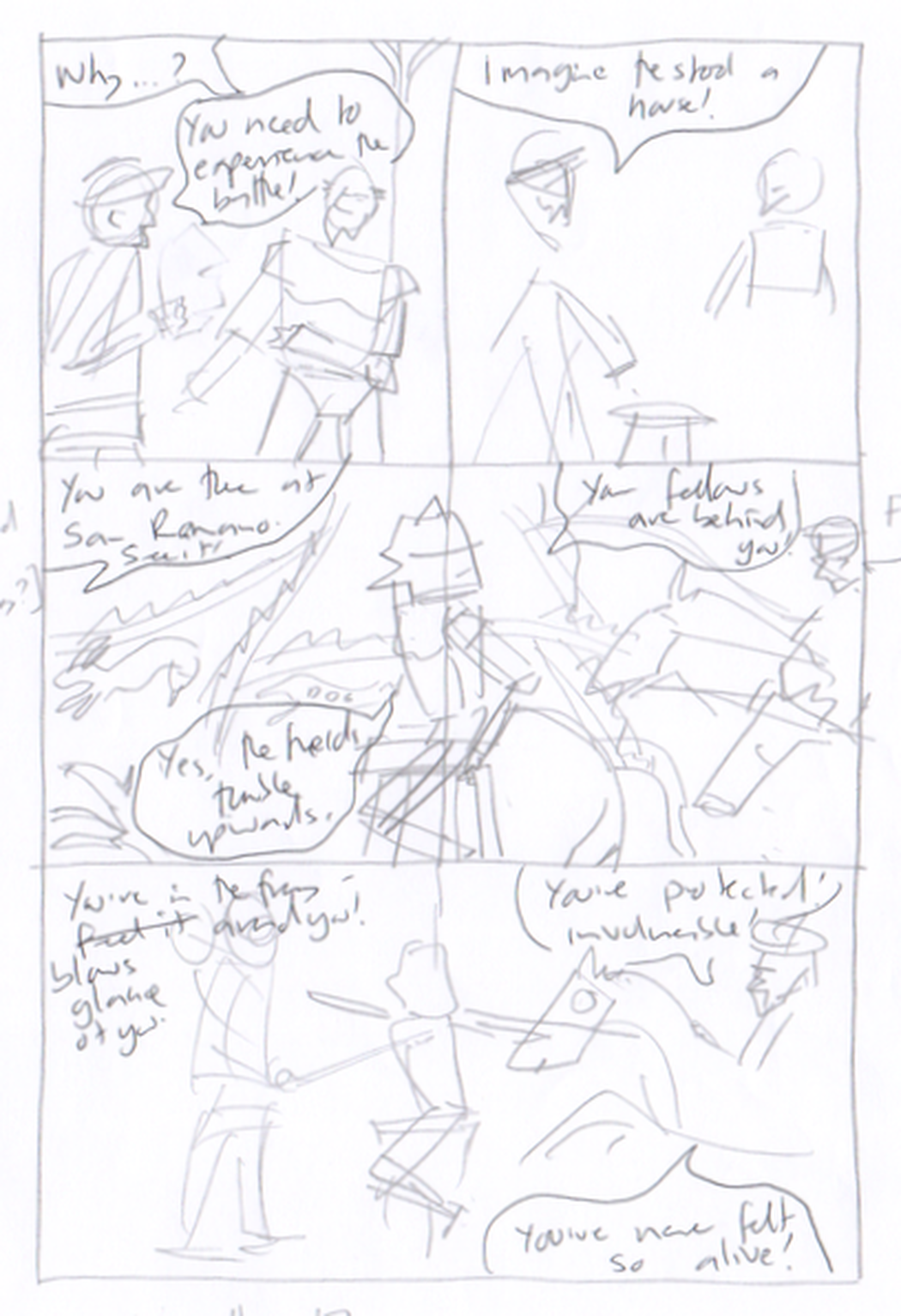







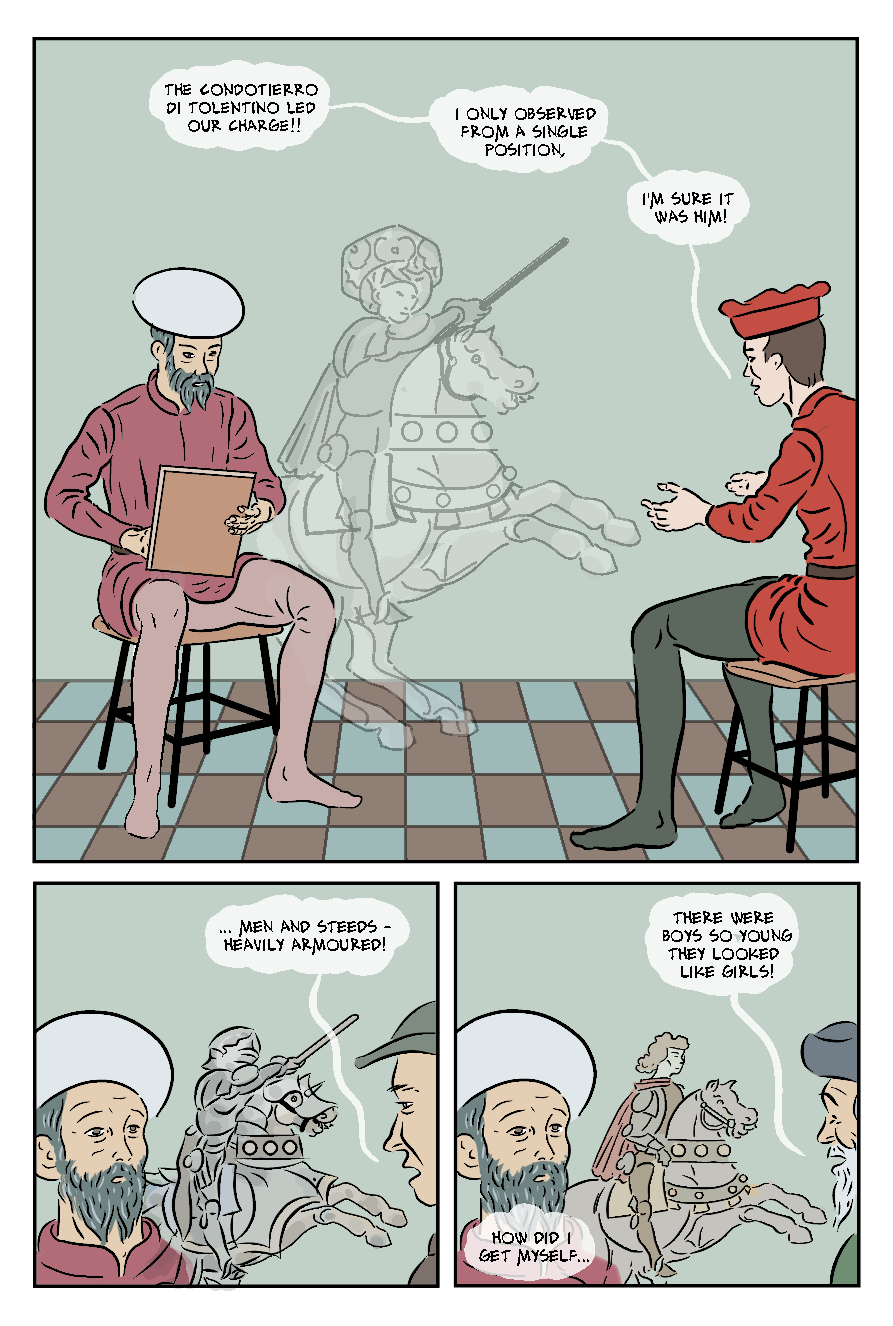
 RSS Feed
RSS Feed